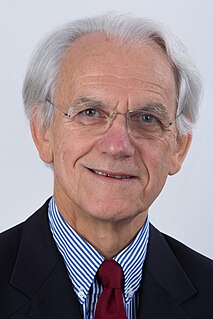
Optical engineering is the field of science and engineering encompassing the physical phenomena and technologies associated with the generation, transmission, manipulation, detection, and utilization of light. Optical engineers use optics to solve problems and to design and build devices that make light do something useful. They design and operate optical equipment that uses the properties of light using physics and chemistry, such as lenses, microscopes, telescopes, lasers, sensors, fiber optic communication systems and optical disc systems.

Gérard Albert Mourou is a French scientist and pioneer in the field of electrical engineering and lasers. He was awarded a Nobel Prize in Physics in 2018, along with Donna Strickland, for the invention of chirped pulse amplification, a technique later used to create ultrashort-pulse, very high-intensity (petawatt) laser pulses.
SPIE is an international not-for-profit professional society for optics and photonics technology, founded in 1955. It organizes technical conferences, trade exhibitions, and continuing education programs for researchers and developers in the light-based fields of physics, including: optics, photonics, and imaging engineering. The society publishes peer-reviewed scientific journals, conference proceedings, monographs, tutorial texts, field guides, and reference volumes in print and online. SPIE is especially well-known for Photonics West, one of the laser and photonics industry's largest combined conferences and tradeshows which is held annually in San Francisco. SPIE also participates as partners in leading educational initiatives, and in 2020, for example, provided more than $5.8 million in support of optics education and outreach programs around the world.
Federico Capasso, a prominent applied physicist, was one of the inventors of the quantum cascade laser during his work at Bell Laboratories. He is currently on the faculty of Harvard University. He has co-authored over 450 papers, edited four volumes, and holds over 60 US patents.

The Special Patrol Insertion/Extraction (SPIE) system was developed as a means to rapidly insert and/or extract a reconnaissance patrol from an area that does not permit a helicopter to land. SPIE has application for rough terrain as well as water inserts/extracts. It is an adaptation of the Vietnam War-era STABO rig.
Bruce J. Tromberg is an American photochemist and a leading researcher in the field of biophotonics. He is the director of the National Institute of Biomedical Imaging and Bioengineering (NIBIB) within the National Institutes of Health (NIH). Before joining NIH, he was Professor of Biomedical Engineering at The Henry Samueli School of Engineering and of Surgery at the School of Medicine, University of California, Irvine. He was the principal investigator of the Laser Microbeam and Medical Program (LAMMP), and the Director of the Beckman Laser Institute and Medical Clinic at Irvine. He was a co-leader of the Onco-imaging and Biotechnology Program of the NCI Chao Family Comprehensive Cancer Center at Irvine.
Chinese Optics Letters is a monthly peer-reviewed scientific journal focusing on optics. Established in 2003, it covers optics research originating in the People's Republic of China as well as coverage from groups outside the country. According to the journal's website, the journal has a 2019 impact factor of 2.045. Although the journal is sponsored by the Chinese Optical Society, it is published in English by the Optical Society. The editor-in-chief is Zhizhan Xu. Subject coverage includes fiber optics and optical communications, lasers and laser optics, nonlinear optics, integrated optics, materials, quantum optics, ultrafast optics, image processing, instrumentation, measurement and metrology.

The University of Arizona College of Optical Sciences, considered the largest institute for optics education in the United States, is dedicated to research and education in optics with an emphasis on optical engineering. The college offers more than 90 courses in optical sciences, and a Bachelor of Science degree in Optical Sciences and Engineering, Masters and Doctoral degree programs in Optical Sciences, as well as a dual master's degree in Optical Sciences and Business Administration. The college also offers comprehensive distance learning courses leading to a Professional Graduate Certificate or a master's degree and markets non-credit short courses on DVD to optics professionals.
Optoacoustics Ltd is a private company that makes fiber optic-based acoustic microphones, fiber optic microphones, headphones, accelerometers, sensors, telephony accessories, and other components, primarily for medical, industrial, environmental and research applications.
Joseph W. Goodman is an engineer and physicist. He received an A.B. degree in Engineering and Applied Physics from Harvard University in 1958 and M.S. and Ph.D. degrees in Electrical Engineering from Stanford University in 1960 and 1963, respectively. He has held a number of positions in the field of optics, including the presidency of the Optical Society of America in 1992.
Gisele Bennett was a professor at the Georgia Institute of Technology and the Director of the GTRI Electro-Optical Systems Laboratory at the Georgia Tech Research Institute (GTRI). She also founded the Logistics and Maintenance Applied Research Center (LandMARC) at GTRI.
James Clair Wyant is professor at the College of Optical Sciences at the University of Arizona where he was Director (1999–2005) and Dean (2005–2012). He received a B.S. in physics from Case Western Reserve University and M.S. and Ph.D. in optics from the University of Rochester.

Rajpal Singh Sirohi is an Indian optics physicist, academic administrator, educator, and researcher in optical metrology. He is the former Director of IIT Delhi and Vice Chancellor of several universities. He is the Fellow of INAE, NASI, OSA, SPIE, OSI and ISoI. He has received numerous awards including Gabor Award of SPIE, Galileo Award of ICO. He is also the recipient of Padma Shri by Govt. of India. He is the author of about 430 papers and several books.

The University of Engineering & Management (UEM), Kolkata is a private university located in New Town, Kolkata. It provides engineering, technological & management education. It was established in 2015 by IEM Trust, Act no. XXV and it is the third engineering institution founded by the IEM-UEM Group. This university is administrated by the Institute of Engineering and Management (IEM) education group trust.
Anurag Sharma is an Indian physicist and a professor at the department of physics of the Indian Institute of Technology, Delhi. He is known for his pioneering researches on optoelectronics and optical communications and is an elected fellow of all the three major Indian science academies viz. Indian Academy of Sciences, Indian National Science Academy and National Academy of Sciences, India as well as Indian National Academy of Engineering. The Council of Scientific and Industrial Research, the apex agency of the Government of India for scientific research, awarded him the Shanti Swarup Bhatnagar Prize for Science and Technology, one of the highest Indian science awards for his contributions to Engineering Sciences in 1998.
Kehar Singh is an Indian optical physicist and an emeritus fellow of the Indian Institute of Technology, Delhi. He is a former CLUSTER chair professor at Swiss Federal Institute of Technology in Lausanne and a former professor of IIT Delhi. He has also served as an academic visitor at Imperial College of Science and Technology, London.

Alexandra Boltasseva is Ron And Dotty Garvin Tonjes Professor of electrical and computer engineering at Purdue University, and editor-in-chief for The Optical Society's Optical Materials Express journal. Her research focuses on plasmonic metamaterials, manmade composites of metals that use surface plasmons to achieve optical properties not seen in nature.
Kevin Rolland Thompson was the Group Director, Research and Development/Optics at Synopsys, Inc. His work contributed to developments in nanolithography, astrophysics and the advancement of optics

Nimmi Ramanujam is the Robert W. Carr Professor of Biomedical Engineering, and a faculty member in the Global Health Institute and the Department of Pharmacology & Cell Biology at Duke University. She is the director of the Center of Global Women's Health Technologies (GWHT) and founder of Zenalux Biomedical Inc. and Calla Health Ramanujam has spent the last two decades developing precision diagnostics and more recently precision therapeutics for breast and cervical cancer, with a focus on addressing global health disparities. She has more than 20 patents and over 150 publications for screening, diagnostic, and surgical applications, and has raised over $30M of funding to pursue these innovations through a variety of funding mechanisms, including NIH R01s and R21s, NIH Bioengineering Partnerships, NCI Academic Industry Partnerships, NIH Small Business grants and USAID funding. As the founding director of the Center for Global Women's Health Technologies at Duke University, she has developed a consortium of over 50+ partners including international academic institutions and hospitals, non-governmental organizations, ministries of health, and commercial partners; this consortium is working to ensure that the technologies developed at the center are adopted by cancer control programs in geographically and economically diverse healthcare settings.







